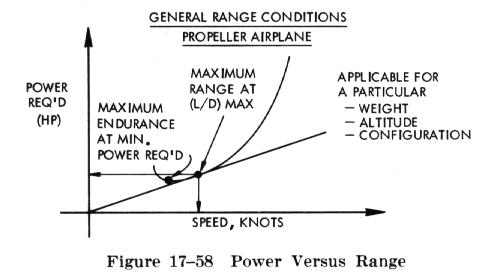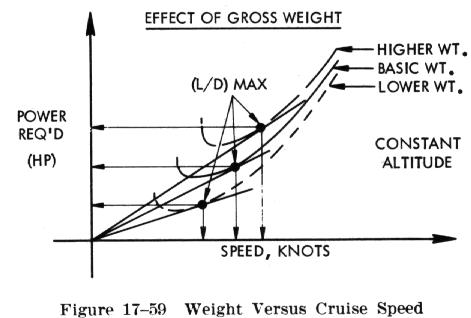Range Performance
Range Performance
The ability of an airplane to convert fuel energy into
flying distance is one of the most important items of airplane performance.
In flying operations, the problem of efficient range operation of an airplane
appears in two general forms: (1) to extract the maximum flying distance
from a given fuel load or (2) to fly a specified distance with a minimum
expenditure of fuel. A common denominator for each of these operating problems
is the "specific range"; that is, nautical miles of flying distance per
pound of fuel. Cruise flight operations for maximum range should be conducted
so that the airplane obtains maximum specific range throughout the flight.
The specific range can be defined by the following relationship:
nautical miles
specific range = ------------------
lbs. of fuel
or
nautical miles/hr.
specific range = --------------------
lbs. of fuel/hr.
or
knots
-----------
fuel flow
f maximum specific range is desired, the flight condition
must provide a maximum of speed versus fuel flow.
The general item of range must be clearly distinguished
from the item of endurance (Fig. 17-58). The item of range involves consideration
of flying distance, while endurance involves consideration of flying time.
Thus, it is appropriate to define a separate term, "specific endurance." |
 |
I
flight hours
specific endurance = ---------------
lbs. of fuel
or
flight hours/hr.
specific endurance = ------------------
lbs. of fuel/hr.
or
1
-----------
fuel flow
{p309}
If maximum endurance is desired, the flight condition must
provide a minimum of fuel flow.
While the peak value of specific range would provide maximum
range operation, long range cruise operation is generally recommended at
some slightly higher airspeed. Most long range cruise operations are conducted
at the flight condition which provides 99 percent of the absolute maximum
specific range. The advantage of such operation is that 1 percent of range
is traded for 3 to 5 percent higher cruise speed. Since the higher cruise
speed has a great number of advantages, the small sacrifice of range is
a fair bargain. The values of specific range versus speed are affected
by three principal variables: (1) airplane gross weight, (2) altitude,
and (3) the external aerodynamic configuration of the airplane. These are
the source of range and endurance operating data included in the performance
section of the airplane's flight handbook.
| "Cruise control" of an airplane implies that the
airplane is operated to maintain the recommended long range cruise condition
throughout the flight. Since fuel is consumed during cruise, the gross
weight of the airplane will vary and optimum airspeed, altitude, and power
setting can also vary. Generally, "cruise control" means the control of
the optimum airspeed, altitude, and power setting to maintain the 99 percent
maximum specific range condition. At the beginning of cruise flight, the
relatively high initial weight of the airplane will require specific values
of airspeed, altitude, and power setting to produce the recommended cruise
condition (Fig. 17-59). As fuel is consumed and the airplane's gross weight
decreases, the optimum airspeed and power setting may decrease, or, the
optimum altitude may increase. In addition, the optimum specific range
will increase. Therefore, the pilot must provide the proper cruise control
technique to ensure that optimum conditions are maintained. |
|
Total range is dependent on both fuel available and specific
range. When range and economy of operation are the principal goals, the
pilot must ensure that the airplane will be operated at the recommended
long range cruise condition. By this procedure, the airplane will be capable
of its maximum design operating radius, or can achieve flight distances
less than the maximum with a maximum of fuel reserve at the destination.
The propeller driven airplane combines the propeller with
the reciprocating engine for propulsive power. In the case of the reciprocating
engine, fuel flow is determined mainly by the shaft power put into the
propeller rather than thrust. Thus, the fuel flow can be related directly
to the power required to maintain the airplane in steady, level flight.
This fact allows for the determination of range through analysis of power
required versus speed - variation of fuel flow versus speed.
The maximum endurance condition would be obtained at the
point of minimum power required since this would require the lowest fuel
flow to keep the airplane in steady, level flight. Maximum range condition
would occur where the proportion between speed and power required is greatest
(Fig. 17-58). The maximum range condition is obtained at maximum lift/drag
ratio (L/D max) and it is important to note that for a given airplane configuration,
the maximum lift/drag ratio occurs at a particular angle of attack and
lift coefficient, and is unaffected by weight or altitude.
The flight condition of maximum lift/drag ratio is achieved
at one particular value of lift coefficient for a given airplane configuration.
Hence, a variation of gross weight will alter the values of airspeed, power
required, and specific range obtained at the maximum lift/drag ratio.
The variations of speed and power required must be monitored
by the pilot as part of the cruise control procedure to maintain the maximum
lift/drag ratio. When the airplane's fuel weight is a small part of the
gross weight and the airplane's range is small, the cruise control procedure
can be simplified to essentially maintaining a constant speed and power
setting throughout the time of cruise flight. On the other hand, the long
range airplane has a fuel weight which is a considerable part of the gross
weight, and cruise control procedures must employ scheduled airspeed and
power changes to maintain optimum range conditions.
| The effect of altitude on the range of the propeller driven
airplane may be understood by inspection of Fig. 17-60. A flight conducted
at high altitude will have a greater true airspeed and the power required
will be proportionately greater than when conducted at sea level. The drag
of the airplane at altitude is the same as the drag at sea level but the
higher true airspeed causes a proportionately greater power required. Note
that the straight line that is tangent to the sea level power curve is
also tangent to the altitude power curve.
The effect of altitude on specific range also can be appreciated
from the previous relationships. If a change in altitude causes identical
changes in speed and power required, the proportion of speed to power required
would be unchanged. The fact implies that the specific range of the propeller
driven airplane would be unaffected by altitude. Actually, this is true
to the extent |
|
that specific fuel consumption and propeller efficiency are the principal
factors which could cause a variation of specific range with altitude.
If compressibility effects are negligible, any variation of specific range
with altitude is strictly a function of engine/propeller performance.
The airplane equipped with the reciprocating engine will
experience very little, if any, variation of specific range with altitude
at low altitudes. There is negligible variation of brake specific fuel
consumption for values of brake horsepower below the maximum cruise power
rating of the engine which is the lean range of engine operation. Thus,
an increase in altitude will produce a decrease in specific range only
when the increased power requirement exceeds the maximum cruise power rating
of the engine. One advantage of supercharging is that the cruise power
may be maintained at high altitude and the airplane may achieve the range
at high altitude with the corresponding increase in true airspeed. The
principal differences in the high altitude cruise and low altitude cruise
are the true airspeeds and climb fuel requirements.


